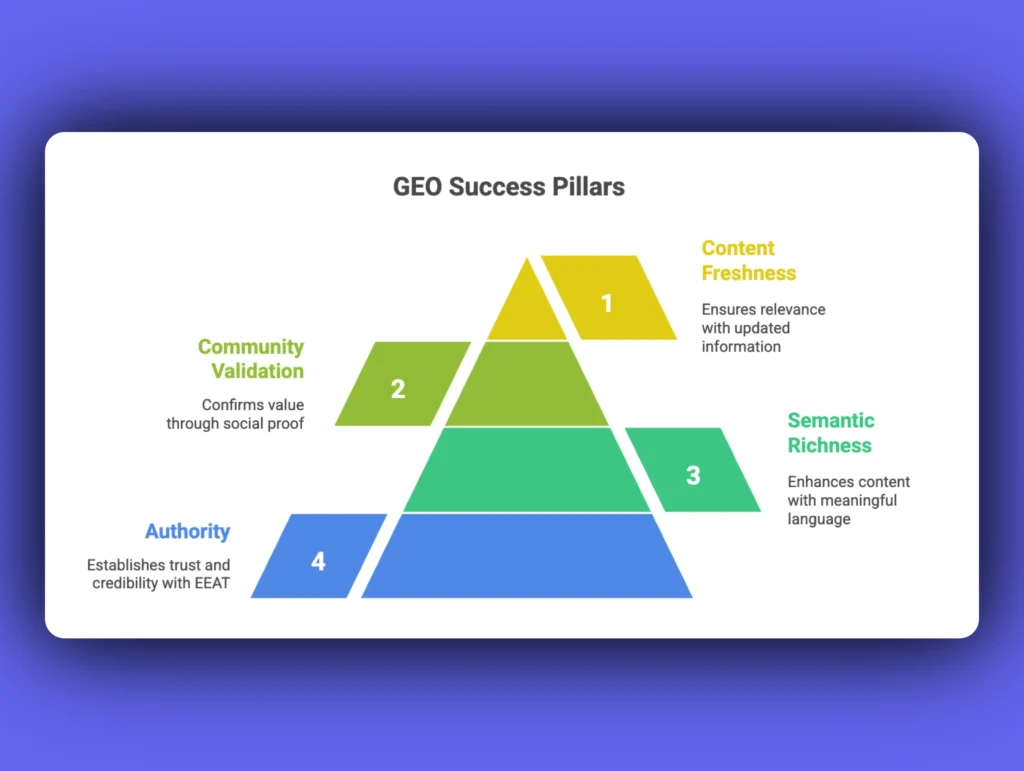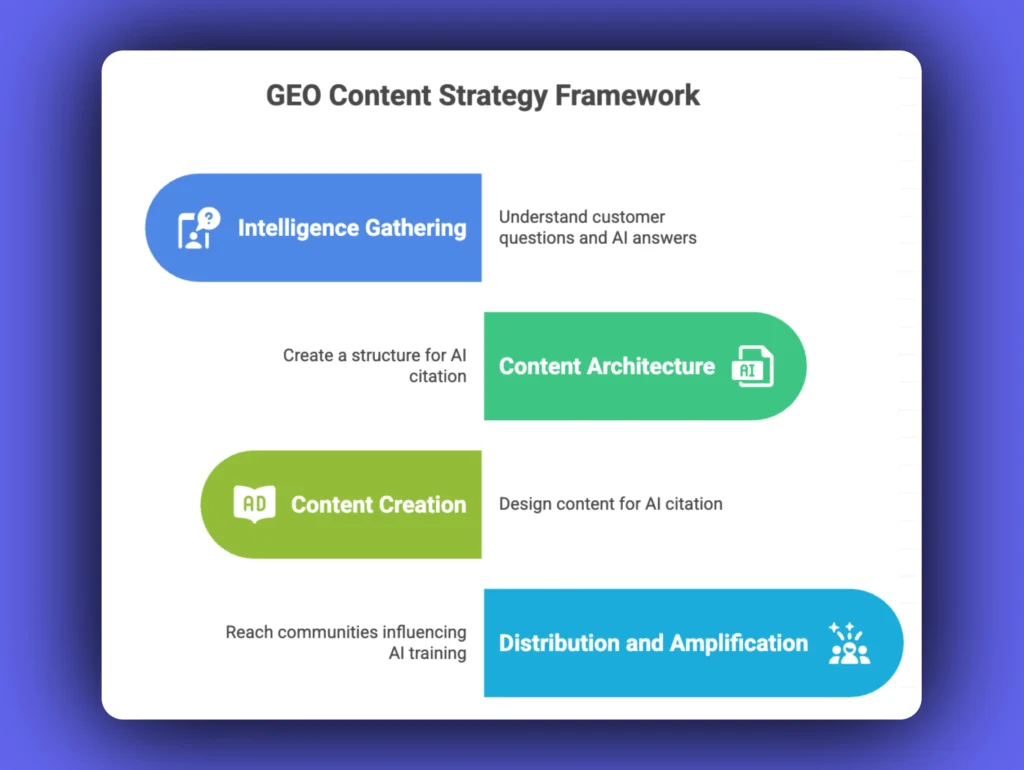Most startups watch their CAC climb, and assume faster growth means higher marketing spend. But what if you could cut acquisition costs and get featured in ChatGPT answers? The secret lies in Generative Engine Optimization (GEO), a content strategy that ensures AI-powered search engines like ChatGPT, Perplexity, and Gemini cite your brand as the go-to solution. At SevenSEO, we combine human strategy with AI agents to slash CAC by up to 30% while ensuring you rank in both Google results and AI-powered overviews. Here’s your complete playbook to dominate AI search through strategic content.
What Is GEO and Why Your Content Strategy Needs It Now
Generative Engine Optimization (GEO) is the practice of structuring your content so that Large Language Models (LLMs), the AI engines powering ChatGPT, Perplexity, Gemini, and Bing Chat, perceive, comprehend, and recommend your brand in their responses.
Think of it this way: When someone asks ChatGPT “What’s the best project management tool for remote teams?” you want your SaaS product in that answer. When they query Perplexity about “top marketing agencies for AI startups,” you want your agency featured prominently.
The numbers tell the story:
- 73% of consumers now use AI tools for research before making purchase decisions
- AI-generated recommendations carry 4x higher trust than traditional display ads
- Companies optimizing for GEO see 25-40% lower customer acquisition costs
- 89% of B2B buyers use AI search at some point in their decision journey
But here’s the crucial difference: Traditional SEO optimizes for search engines that show you links. GEO optimizes for AI engines that give you answers. Your content isn’t competing for clicks, it’s competing to be the answer.
The 4 Non-Negotiable Pillars of GEO Success
Before diving into content strategy, you need to understand the foundational pillars that make GEO work. Miss any of these, and your efforts will fall flat.
Pillar 1: E-E-A-T Authority (The Trust Builder)
Why it matters: AI models heavily weight experience, expertise, authoritativeness, and trustworthiness when deciding which sources to cite.
Must-have elements:
- Author bylines with credentials: Every piece of content should have a named author with relevant expertise
- About pages with team bios: AI models look for human expertise behind the content
- Industry recognition: Awards, certifications, and mentions in reputable publications
- Original research and data: AI models prioritize unique insights over rehashed content
- Editorial standards: Clear fact-checking and content review processes
Quick win: Add detailed author bios to your top 10 performing articles, including credentials and industry experience. This immediately boosts your authority signals.
Pillar 2: Semantic Richness (The Language Layer)
Why it matters: AI models understand context and meaning, not just keywords. Your content needs to speak their language.
Must-have elements:
- Structured data markup: Schema markup helps AI models understand your content context
- Natural language patterns: Conversational tone that mirrors how people actually speak
- Contextual relationships: Clear connections between concepts, ideas, and solutions
- Question-answer formatting: Content structured to directly address user queries
- Comprehensive topic coverage: In-depth exploration of subjects rather than surface-level treatment
Quick win: Implement FAQ schema markup on your most important pages. This structured format is exactly what AI models look for when generating answers.
Pillar 3: Community Validation (The Social Proof)
Why it matters: AI models consider community discussions, reviews, and social mentions as validation signals.
Must-have elements:
- Active social media presence: Regular, engaging content that generates discussions
- Community participation: Meaningful contributions to industry forums, Reddit, and professional networks
- Customer testimonials and reviews: Real user feedback across multiple platforms
- Industry mentions: References in trade publications, podcasts, and expert roundups
- User-generated content: Encouraging customers to create content about your brand
Quick win: Identify the top 3 Reddit communities where your ideal customers hang out and start providing helpful, non-promotional answers to their questions.
Pillar 4: Content Freshness (The Relevance Factor)
Why it matters: AI models favor current, up-to-date information when generating responses.
Must-have elements:
- Regular content updates: Refreshing existing content with new data and insights
- Trending topic coverage: Addressing current industry discussions and developments
- Real-time data integration: Including current statistics and market information
- News and commentary: Providing expert perspectives on industry developments
- Content audit schedule: Systematic review and updating of existing content
Quick win: Update your top 5 performing articles with current statistics and 2025 data. Add a “Last updated” date to show freshness.

Building Your GEO Content Strategy: The 4-Phase Framework
Now that you understand the pillars, let’s build a content strategy that actually works. This isn’t theory, it’s a battle-tested framework we use at SevenSEO to help startups dominate AI search.
Phase 1: Intelligence Gathering
The goal: Understand what questions your ideal customers are asking AI tools and what answers they’re currently getting.
Step 1: AI Query Research
- Test 10+ relevant queries across ChatGPT, Perplexity, Gemini, and Bing Chat
- Document which brands/companies get mentioned in responses
- Identify gaps where no clear winner emerges
- Note the format and style of information AI models prefer
Step 2: Competitor AI Analysis
- Search for your top 5 competitors across AI platforms
- Analyze what content of theirs gets cited most often
- Identify their content gaps and weaknesses
- Document their authority signals and content approaches
Step 3: Customer Journey Mapping
- Map out every question a prospect might ask at each stage of their buying journey
- Prioritize questions by search volume and business impact
- Identify the most valuable “zero-moment-of-truth” queries
- Create a master list of target questions to answer
Quick implementation: Start with just 10 core questions your customers ask. Test them across 3 AI platforms and document the current landscape.
Phase 2: Content Architecture
The goal: Create a content structure that maximizes your chances of being cited by AI models.
The Pillar and Spoke Model:
Content Pillars (3-5 main topics):
- Comprehensive, authoritative guides
- Cover your core expertise areas exhaustively and build topical authority
- Include multiple subtopics and related questions
- Update monthly with fresh data and insights
Content Spokes (20-30 supporting articles):
- Address specific questions within each hub topic
- 800-1,500 words of focused, actionable content
- Link back to relevant pillar content
- Optimized for specific AI queries
Content Satellites (50+ supporting pieces):
- FAQ pages, case studies, tool comparisons
- Social media content, podcast appearances
- Guest posts and industry contributions
- Community discussions and forum answers
Example Architecture for a Marketing Agency:
Pillar 1: Startup Growth Marketing
- Spokes: “How to calculate startup CAC,” “Growth hacking for B2B SaaS,” “Marketing budget allocation for startups”
- Satellites: Case studies, tool comparisons, ROI calculators
Pillar 2: AI-Powered SEO
- Spokes: “GEO vs traditional SEO,” “AI content creation best practices,” “Measuring AI search performance”
- Satellites: Tool reviews, implementation guides, expert interviews
Phase 3: Content Creation for AI Optimization
The goal: Create content specifically designed to be cited by AI models.
Start with the Answer (The Citation Hook)
Every piece of content should begin with a clear, quotable statement that directly answers the main question.
Poor example: “Customer acquisition is a complex challenge that many startups face in today’s competitive landscape…”
GEO-optimized example: “B2B startups that implement AI-powered content strategies see 40% lower customer acquisition costs within 6 months, with the average cost per lead dropping from $150 to $90.”
Use the Question-Answer Framework
Structure your content as a series of questions and direct answers.
## How Much Should Startups Spend on Content Marketing?
Startups should allocate 15-25% of their total marketing budget to content creation and distribution. For a startup with a $10,000 monthly marketing budget, this means $1,500-$2,500 should go toward content marketing.
### Why This Range Works:
- 15% minimum ensures consistent content production
- 25% maximum prevents over-investment before proving ROI
- Sweet spot for most startups is 20% of marketing budget
### Budget Breakdown Example:
- Content creation: 60% ($900-$1,500)
- Content promotion: 25% ($375-$625)
- Tools and software: 15% ($225-$375)
Include Statistical Backing
AI models love citing specific data. Include numbers, percentages, case studies, and research findings in every major point.
Data points to include:
- Industry benchmarks and averages
- Performance improvements and ROI figures
- Timeline expectations for results
- Comparison data between different approaches
- Success metrics and KPIs
Write in Natural Language
AI models favor conversational, natural language over corporate jargon.
Jargony: “Leverage synergistic methodologies to optimize conversion funnels”
Natural: “Use these three tactics to get more visitors to become customers”
Create Scannable Structure
Use bullet points, numbered lists, and clear headings to make content easy for AI models to parse and quote.
Essential formatting elements:
- Single H1 per page
- H2 and H3 headings that are actual questions
- Bullet points for lists and key takeaways
- Numbered steps for processes
- Bold text for important statistics
- Short paragraphs (2-3 sentences max)
Phase 4: Distribution and Amplification
The goal: Get your content in front of the communities and platforms that influence AI model training.
Multi-Channel Distribution Strategy:
Owned Media Optimization
- Publish content on your website with proper schema markup
- Create LinkedIn articles and posts highlighting key insights
- Develop email newsletter content that drives engagement
- Produce podcast content or appear on industry shows
Community Engagement
- Share insights in relevant Reddit communities (r/startups, r/marketing, r/entrepreneur)
- Participate in industry Facebook groups and Slack communities
- Answer questions on Quora and industry-specific forums
- Engage in Twitter/X conversations using relevant hashtags
Earned Media Amplification
- Pitch unique data and insights to industry publications
- Offer expert commentary on trending topics
- Collaborate with other experts on joint content pieces
- Seek speaking opportunities at virtual and in-person events
Strategic Partnerships
- Participate in expert roundups and interviews
- Cross-promote content with non-competing brands
- Develop content partnerships with industry tools and platforms

High-Impact GEO Content Strategies That Drive Results
The Answer Engine Optimization Approach
Different AI platforms have different preferences. Here’s how to optimize for each:
ChatGPT Optimization:
- Focus on comprehensive, step-by-step explanations
- Use clear definitions followed by practical examples
- Include multiple perspectives on complex topics
- Structure content as tutorials and how-to guides
Perplexity Optimization:
- Emphasize recent data and current statistics
- Include source citations within your content
- Focus on research-backed insights and analysis
- Create content that reads like mini-research papers
Google Gemini Optimization:
- Optimize for featured snippets first
- Use schema markup extensively
- Focus on local and industry-specific content
- Create content that answers “near me” and location-based queries
Bing Chat/Copilot Optimization:
- Focus on business and professional use cases
- Include practical templates and frameworks
- Emphasize ROI and business impact
- Structure content for B2B decision-makers
The Community Intelligence Strategy
Here’s an insider secret most agencies miss: AI models heavily weight community discussions and user-generated content. Reddit, in particular, is a goldmine for GEO because AI models view it as authentic user sentiment.
The Reddit GEO Playbook:
Identify Your Subreddits
Find 5-10 communities where your ideal customers ask questions:
- r/startups (2.1M members) – for startup-focused content
- r/marketing (1.8M members) – for marketing strategies
- r/entrepreneur (1.5M members) – for business growth
- r/SEO (200K members) – for technical SEO discussions
- Industry-specific subreddits for your niche
The Value-First Approach
- Answer questions thoroughly without promoting your brand
- Share templates, frameworks, and actionable advice
- Reference your content naturally when it genuinely helps
- Build a reputation as a helpful expert
Create Reddit-Worthy Content
- Develop resources that Redditors naturally want to share
- Create controversial but well-researched takes on industry topics
- Share behind-the-scenes insights and lessons learned
- Offer free tools and templates that solve real problems
The Data-Driven Content Creation System
Monthly Content Audits:
- Track which of your articles get cited by AI models
- Monitor changes in AI responses to key queries
- Identify new opportunities based on competitor analysis
- Update content based on performance data
AI Mention Tracking: Set up monitoring for:
- Your brand name + “recommended by” or “according to”
- Your content titles appearing in AI responses
- Industry keywords where you want to be mentioned
- Competitor mentions to identify content gaps
Performance Metrics That Matter:
- AI citation frequency across different platforms
- Brand mention context (positive, neutral, negative)
- Query coverage percentage (how many relevant queries return your content)
- Traffic from AI-referred sources
- Conversion rates from AI-discovered traffic
Common GEO Content Mistakes That Kill Results
- Mistake #1: Keyword Stuffing for AI AI models are sophisticated enough to detect and penalize unnatural language. Write for humans first, optimize for AI second.
- Mistake #2: Ignoring Content Freshness Publishing once and forgetting about it won’t work. AI models favor current, regularly updated content.
- Mistake #3: Surface-Level Content AI models prefer comprehensive, authoritative content over shallow, keyword-focused articles.
- Mistake #4: Missing Community Engagement Creating content without participating in relevant communities severely limits your GEO potential.
- Mistake #5: One-Size-Fits-All Approach Different AI platforms favor different content styles and formats. Customize your approach.
The Bottom Line: Why GEO Content Strategy Isn’t Optional
Traditional content marketing optimizes for search engines that show links. GEO content marketing optimizes for AI engines that give answers. The difference isn’t subtle—it’s business-critical.
If you’re not part of the AI-generated answer, you’re not part of the buyer’s journey. It’s that simple.
The opportunity window is closing fast:
- Early adopters are already seeing 25-40% lower CAC
- Competition for AI attention will intensify rapidly
- The brands that establish authority now will dominate tomorrow
- Traditional content approaches are becoming less effective monthly
Your competitive advantage lies in moving now: While your competitors debate whether GEO matters, you can be building the content authority that will dominate AI search results for years to come.
